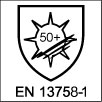Standards Guide
 EN 14404+A1 Standard
EN 14404+A1 Standard
It defines the requirements for knee protection in all work activities requiring kneeling. It applies to our trousers in combination with our kneepads. The Cordura® and Oxford Tech knee pockets + France Textile knee pads contribute to the resistance to object penetration at a force of at least 100 newtons (level 1). Our knee pads are classified as type 2 because they fit into the work trouser's built-in knee pocket.

 EN ISO 20471 standard
EN ISO 20471 standard
It specifies the requirements for high visibility clothing that can visually indicate the presence of the wearer. These garments are intended to be seen in all light conditions, day and night. This standard controls the surface area of the retro-reflective strips and the surface area of fluorescent material, which is listed in classes from 1 to 3.

 EN ISO 13688 standard
EN ISO 13688 standard
International standard specifying general performance requirements for ergonomics, safety, size designation, ageing, compatibility and marking of protective clothing and information to be provided by us with protective clothing. It is only used in conjunction with other standards containing requirements for protective performance.

 EN 343 Standard
EN 343 Standard
It applies to the performance of materials and garments in protecting against adverse weather, rain, fog and soil moisture. It meets technical requirements for clothing such as welded seams or the use of waterproof fabrics. This standard controls 2 points:
- The resistance to water penetration in the garment, categorized from 1 to 3
- Resistance to breathability of the garment, categorised from 1 to 3

 EN ISO 20345 Standard
EN ISO 20345 Standard
I t guarantees that the shoes are suitable for the world of work and for professionals. It ensures the presence of a protective toe cap on the front of the shoe to protect the toes from shocks equivalent to 200 joules. It also protects against the risk of crushing above a load of 1500 decanewtons. According to this standard, there are several classifications defining the use for which safety shoes are intended (SB, S1, S2, S3, S4, S5, S7).

 ESD standard
ESD standard
European standard in addition to the main standards S1, S1P, S2, S3 ..., it allows to dissipate the electrostatic charges accumulated on the human body, thanks to an antistatic treatment of the outer and inner soles.

 EN 388 standard
EN 388 standard
This European Standard specifies the requirements, test methods, markings and information to be provided for protective gloves against the mechanical risks of abrasion, slashing, tearing, puncture and, where applicable, impact. The standard measures 4 levels of resistance to the following aggressions:
A: Abrasion resistance (from 1 to 4)
B: Resistance to cutting by blades (from 1 to 5)
C: Resistance to tearing (from 1 to 4)
D: Puncture resistance (from 1 to 4)
As there is no such thing as an ideal glove, it is necessary to find the right compromise between these 4 indicators. When an X replaces a number, the aggression test has not been tested.

 EN 420 standard
EN 420 standard
The EN 420 standard specifies the general requirements in terms of ergonomics, dexterity, safety, marking, information and instructions for use for gloves. For optimal use, it is important that the glove is the right size.

 EN 812 Standard
EN 812 Standard
The EN 812 standard covers the safety requirements for protective headgear. It is designed to protect workers in the event of an impact between the head and hard, immobile objects that could cause cuts and superficial injuries. It covers the specific requirements for head protection, the test methods for testing helmets and the marking on each helmet to certify compliance with the standard. EN 812 does not cover protective equipment designed to protect the head from projections and/or falling objects or moving suspended loads.

 EN 14058 Standard
EN 14058 Standard
EN 14058 standard workwear and clothing protect you from the cold down to -5°C. This standard specifies the performance and resistance levels required for workwear designed to protect against moderately cold environments, at temperatures of -5°C or above, as cold is considered a factor contributing to discomfort below 5° Celsius.

 EN 13758 Standard
EN 13758 Standard
European Standard 13758 defines the labelling requirements for clothing designed to protect wearers from exposure to ultraviolet rays from the sun. The standard specifies how the protection factor of clothing is measured and what must appear on the label so that wearers can easily understand it.
The standard describes a UV radiation test on textiles in a new, dry and unstretched state, with a solar spectrum corresponding to the solar radiation in New Mexico (United States). The protection factor (UPF) must be at least 40 for a textile to be certified as UV protective clothing.
The standard is divided into two parts:
- EN 13758-1 describes the method for measuring the UV protection factor (UPF), i.e. the material's ability to block UV rays.
- EN 13758-2 specifies how garments offering this protection should be labelled so that consumers can quickly identify products that actually provide protection.



